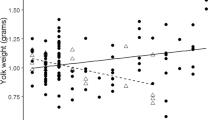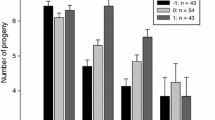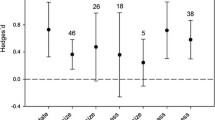Abstract
Maternal effects can function as a mechanism of transgenerational plasticity by which the environment experienced by parents is translated into the offspring phenotype and fitness. In birds, parents may affect the competitive ability of their offspring, and hence their fitness, by modifying their hatching pattern and/or egg size. However, little is known about how mothers can modify offspring phenotypes and their fitness in response to a sudden change in environmental conditions during egg-laying. Here, we studied the effect of supplemental food during egg-laying on hatching asynchrony and egg size in the Eurasian roller (Coracias garrulus), a species with marked hatching asynchrony. We also explored the effects of maternal investment on offspring fitness. Food supplementation did not affect hatching asynchrony. However, females in food-supplemented nests laid eggs that increased in size with laying order except for an ultimate small egg. Meanwhile, size of eggs laid by females in control nests did not change with laying order. Supplemental food positively affected hatchability of the egg laid just before the last one and negatively affected hatchability of the last laid egg, which seemed to be a side effect of egg size. Consequently, food-supplemented nests produced fewer fledglings and had higher probabilities of suffering brood reduction than control nests. We conclude that egg size in rollers is a plastic trait, sensitive to short-term changes in food conditions. Furthermore, our results show that maternal investment in egg size may potentially affect offspring fitness.



Similar content being viewed by others
References
Andersson DJ, Reeve J, Bird DM (2003) Sexually dimorphic eggs, nestling growth and sibling competition in American kestrels Falco sparverius. Funct Ecol 11:331–335
Avilés JM, Parejo D, Rodríguez J (2011) Parental favouritism strategies in the asynchronously hatching European Roller (Coracias garrulus). Behav Ecol Sociobiol 65:1549–1557
Badyaev AV, Hamstra TL, Oh KP, Seaman DAA (2006) Sex-biased maternal effects reduce ectoparasite-induced mortality in a passerine bird. P Natl Acad Sci USA 103:14406–14441
Bernardo J (1996) Maternal effects in animal ecology. Am Zool 36:83–105
Bize P, Romain P, Moureau B, Heeb P (2006) A UV signal of offspring condition mediates context-dependent parental favouritism. Proc R Soc B 273:2063–2068
Bonisoli-Alquati A, Martinelli R, Rubolini D, Saino N (2008) Sex-specific effects of albumen removal and nest environment manipulation on barn swallows nestlings. Ecology 89:2315–2324
Bonisoli-Alquati A, Boncoraglio G, Caprioli M, Saino N (2011) Birth order, individual sex and sex of competitors determine the outcome of conflict among siblings over parental care. Proc R Soc B 278:1273–1279
Budden AE, Beissinger SR (2005) Egg mass in an asynchronously hatching parrot: does variation offset constraints imposed by laying order? Oecologia 144:318–326
Charnov EL (1982) Parent–offspring conflict over reproductive effort. Am Nat 119:736–737
Christians JK (2002) Avian egg size: variation within species and inflexibility within individuals. Biol Rev 77:1–26
Clark AB, Wilson DS (1981) Avian breeding adaptations—hatching asynchrony, brood reduction, and nest failure. Q R Biol 56:253–277
Cramp S, Simmons KEL (1988) The birds of the western Palearctic. Oxford University Press, Oxford
D’Alba L, Shawkey MD, Korsten P, Vedder O, Sjouke AK, Komdeur J, Beissinger SR (2010) Differential deposition of antimicrobial proteins in blue tit (Cyanistes caeruleus) clutches by laying order and male attractiveness. Behav Ecol Sociobiol 64:1037–1045
Dzialowski EM, Sotherland PR (2004) Maternal effects of egg size on emu Dromaius novaehollandiae egg composition and hatchling phenotype. J Exp Biol 207:597–606
Eikenaar C, Berg ML, Komdeur J (2003) Experimental evidence for the influence of food availability on incubation attendance and hatching asynchrony in the Australian reed warbler Acrocephalus australis. J Avian Biol 34:419–427
Engqvist L (2005) The mistreatment of covariate interaction terms in linear model analyses of behavioural and evolutionary ecology studies. Anim Behav 70:967–971
Fernández GJ, Reboreda JC (2008) Between and within clutch variation of egg size in greater rheas. Wilson J Ornithol 120:674–682
Forbes S, Mock DW (2000) A tale of two strategies: life-history aspects of family strife. Condor 102:23–34
Forbes S, Wiebe M (2010) Egg size and asymmetric sibling rivalry in red-winged blackbirds. Oecologia 163:361–372
Gasparini J, Boulinier T, Gill VA, Gil D, Hatch SA, Roulin A (2007) Food availability affects the maternal transfer of androgens and antibodies into eggs of a colonial seabird. J Evol Biol 20:874–880
Glassey B, Forbes S (2002) Begging and asymmetric nestling competition. In: Wright J, Leonard ML (eds) The evolution of begging: competition, cooperation and communication. Kluwer, Dordrecht, pp 269–281
Grindstaff JL, Brodie ED, Ketterson ED (2003) Immune function across generations: integrating mechanism and evolutionary process in maternal antibody transmission. Proc R Soc B 270:2309–2319
Grindstaff JL, Demas GE, Ketterson ED (2005) Diet quality affects egg size and number but does not reduce maternal antibody transmission in Japanese quail Coturnix japonica. J Anim Ecol 74:1051–1058
Heeb P (1994) Intraclutch egg-mass variation and hatching asynchrony in the jackdaw Corvus monedula. Ardea 82:87–297
Howe HF (1976) Egg size, hatching asynchrony, sex, and brood reduction in common grackle. Ecology 57:1195–1207
Hoyt DF (1979) Practical methods of estimating volume and fresh weight of bird eggs. Auk 96:73–77
Karell P, Kontiainen P, Pietiainen H, Siitari H, Brommer JE (2008) Maternal effects on offspring Igs and egg size in relation to natural and experimentally improved food supply. Funct Ecol 22:682–690
Kontiainen P, Brommer JE, Karell P, Pietiainen H (2008) Heritability, plasticity and canalization of Ural owl egg size in a cyclic environment. J Evol Biol 21:88–96
Kontiainen P, Pietiainen H, Karell P, Pihlaja T, Brommer JE (2010) Hatching asynchrony is an individual property of female Ural owls which improves nestling survival. Behav Ecol 21:722–729
Kozlowski CP, Ricklefs RE (2010) Egg size and yolk steroids vary across the laying order in cockatiel clutches: a strategy for reinforcing brood hierarchies? Gen Comp Endocrinol 168:460–465
Kramer CY (1956) Extension of multiple range tests to group means with unequal numbers of replications. Biometrics 12:307–310
Krist M (2011) Egg size and offspring quality: a meta-analysis in birds. Biol Rev 86:692–716
Ligon RA, Hill GE (2010) Feeding decisions of eastern bluebirds are situationally influenced by fledgling plumage color. Behav Ecol 21:456–464
Maddox JD, Weatherhead PJ (2008) Egg size variation in birds with asynchronous hatching: is bigger really better? Am Nat 171:358–365
Moreno J, Lobato E, Morales J, Merino S, Martínez de la Puente J, Tomás G (2008) Pre-laying nutrition mediates maternal effects on offspring immune capacity and growth in the pied flycatcher. Oecologia 156:727–735
Mousseau TA, Fox CW (1998) The adaptive significance of maternal effects. Trends Ecol Evol 13:403–407
Nager RG, Monaghan P, Houston DC (2000) Within-clutch trade-offs between the number and quality of eggs: experimental manipulations in gulls. Ecology 81:1339–1350
Parejo D, Silva N, Avilés JM (2007) Within-brood size differences affect innate and acquired immunity in roller Coracias garrulus nestlings. J Avian Biol 38:717–725
Parejo D, Avilés JM, Rodríguez J (2010) Visual cues and parental favouritism in a nocturnal bird. Biol Let 6:171–173
Pihlaja M, Siitari H, Alatalo RV (2006) Maternal antibodies in a wild altricial bird: effects on offspring immunity, growth and survival. J Anim Ecol 75:1154–1164
Reed WL, Clark ME, Vleck CM (2009) Maternal effects increase within-family variation in offspring survival. Am Nat 174:685–695
Rodríguez J, Avilés JM, Parejo D (2011) The value of nest-boxes in the conservation of Eurasian rollers Coracias garrulus in southern Spain. Ibis 153:735–745
Rosivall B, Szollosi E, Torok J (2005) Maternal compensation for hatching asynchrony in the collared flycatcher Ficedula albicollis. J Avian Biol 36:531–537
Royle NJ, Surai PF, Hartley IR (2001) Maternally derived androgens and antioxidants in bird eggs: complementary but opposing effects? Behav Ecol 12:381–385
Saino N, Romano M, Caprioli M, Ambrosini R, Rubolini D, Fasola M (2010a) Sex allocation in yellow-legged gulls (Larus michahellis) depends on nutritional constraints on production of large last eggs. Proc R Soc B 277:1203–1208
Saino N, Romano M, Rubolini D, Caprioli M, Fasola M (2010b) Food supplementation affects egg albumen content and body size asymmetry among yellow-legged gull siblings. Behav Ecol Sociobiol 64:1813–1821
Schielzeth H, Forstmeier W (2009) Conclusions beyond support: overconfident estimates in mixed models. Behav Ecol 20:416–420
Schwabl H (1993) Yolk is a source of maternal testosterone for developing birds. Proc Natl Acad Sci USA 90:11446–11450
Schwabl H, Mock DW, Gieg JA (1997) A hormonal mechanism for parental favouritism. Nature 386:231
Slagsvold T, Sandvik J, Rofstad G, Lorentsen O, Husby M (1984) On the adaptive value of intraclutch egg-size variation in birds. Auk 101:685–697
Svagelj WS, Quintana F (2011) Egg size variation in the imperial cormorant: on the importance of individual effects. Condor 113:528–537
Valkama J, Korpimaki E, Holm A, Hakkarainen H (2002) Hatching asynchrony and brood reduction in Tengmalm’s owl Aegolius funereus: the role of temporal and spatial variation in food abundance. Oecologia 133:334–341
Viñuela J (1997) Adaptation vs. constraint: intraclutch egg-mass variation in birds. J Anim Ecol 66:781–792
Wellicome TI (2005) Hatching asynchrony in burrowing owls is influenced by clutch size and hatching success but not by food. Oecologia 142:326–334
White FN, Kinney JL (1974) Avian incubation. Science 186:107–115
Whittingham LA, Schwabl H (2002) Maternal testosterone in tree swallow eggs varies with female aggression. Anim Behav 63:63–67
Wiebe KL, Bortolotti GR (1994) Food-supply and hatching spans of birds. Energy constraints or facultative manipulation. Ecology 75:813–823
Wiebe KL, Wiehn J, Korpimaki E (1998) The onset of incubation in birds: can females control hatching patterns? Anim Behav 55:1043–1052
Williams TD (1994) Intraspecific variation in egg size and egg composition in birds: effects on offspring fitness. Biol Rev 69:35–59
Acknowledgments
We thank Manolo Soler for his help finding mealworms. This research was funded by the Spanish Ministry of Education and Science/FEDER (CGL2008-00718).
Ethical standards
The experiment presented in this manuscript complies with the current laws of Spain, where the study was performed. The authorisation for carrying out the experiment was granted by Consejería de Medio Ambiente, Junta de Andalucía, Spain.
Author information
Authors and Affiliations
Corresponding author
Additional information
Communicated by J. A. Graves
Ethical standards
The experiment presented in this manuscript complies with the current laws of Spain, where the study was performed. The authorisation for carrying out the experiment was granted by Consejería de Medio Ambiente, Junta de Andalucía, Spain.
Rights and permissions
About this article
Cite this article
Parejo, D., Avilés, J.M. & Rodríguez, J. Supplemental food affects egg size but not hatching asynchrony in rollers. Behav Ecol Sociobiol 66, 1097–1105 (2012). https://doi.org/10.1007/s00265-012-1360-1
Received:
Revised:
Accepted:
Published:
Issue Date:
DOI: https://doi.org/10.1007/s00265-012-1360-1




